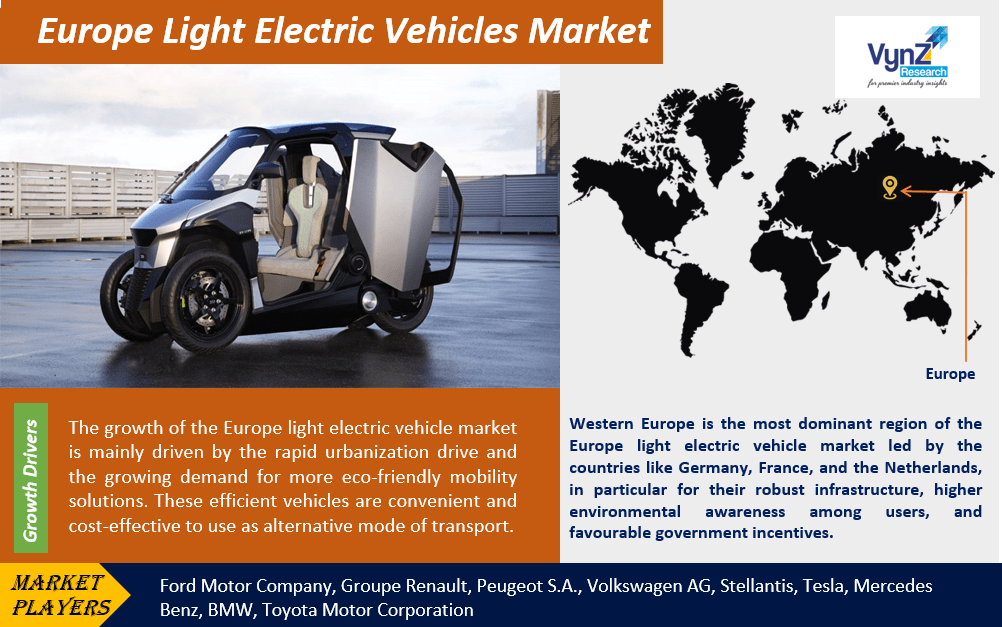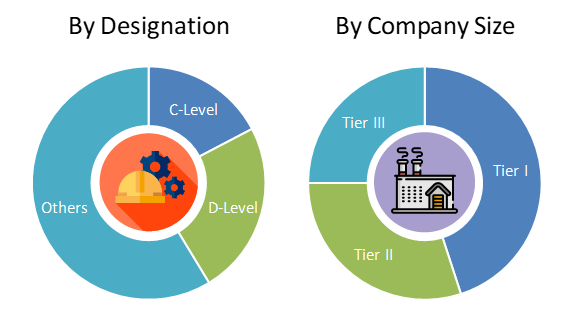| Status : Published | Published On : Oct, 2024 | Report Code : VRAT9636 | Industry : Automotive & Transportation | Available Format :

|
Page : 94 |

Europe Light Electric Vehicle Market Size & Share | Growth Forecast Report 2030
Industry Insights By Product (Hybrid Electric Vehicles(HEVs), Plug-in Hybrid Electric Vehicles (PHEVs), and Battery Electric Vehicles (BEVs)), By Voltage (24V, 36V, 48V, 60V, and 72V), By Application (E-Vehicles for Personal Use, Commercial Applications, Sports, Shared Mobility Solutions), By Battery (Lithium cobalt batteries (LCA), Lithium-ion polymer batteries (LiPo), and Nickel-metal hydride batteries (NIMH)) and By Geography (Western Europe, Northern Europe and Southern Europe )
Industry Overview
The Europe Light Electric Vehicle Market size was valued at USD 4.4 billion in 2023. It is likely to grow up to USD 9.2 billion by 2030 at a CAGR of 8.6% during the forecast period ranging between 2025 and 2030. One of the most significant factors that drives the growth of this market is the strict regulation imposed by the governments on the emission of traditional vehicles. This strict standard of the European Union encourages consumers to adopt electric vehicles pushing them towards a cleaner transportation solution offered by the Light Electric Vehicles (LEVs) .

A Light Electric Vehicle (LEV) refers to an eco-friendly mode of transport such as e-bikes, e-scooters, and electric skateboards. These compact vehicles are powered by electricity instead of gasolene. They have rechargeable batteries made normally of lithium-ion. There is also an electric motor that helps in propulsion. These vehicles are ideal for urban mobility, especially for traveling short distances. These vehicles reduce traffic congestion, carbon emissions, operational costs, and hassles for parking. They are most sustainable option for cities and campusesfor personal mobility or for delivery services.
Europe Light Electric Vehicle Market Report Coverage
|
Report Metric |
Details |
|
Historical Period |
2018 - 2023 |
|
Base Year Considered |
2024 |
|
Forecast Period |
2025 - 2030 |
|
Market Size in 2024 |
U.S.D. 4.4 Billion |
|
Revenue Forecast in 2030 |
U.S.D. 9.2 Billion |
|
Growth Rate |
8.6% |
|
Segments Covered in the Report |
By Product, By Voltage, By Application and By Battery |
|
Report Scope |
Market Trends, Drivers, and Restraints; Revenue Estimation and Forecast; Segmentation Analysis; Impact of COVID-19; Companies’ Strategic Developments; Market Share Analysis of Key Players; Company Profiling |
|
Regions Covered in the Report |
Western Europe, Northern Europe and Southern Europe |
Europe Light Electric Vehicle Industry Dynamics
Europe Light Electric Vehicle Market Trends/ Growth Drivers:
Growing urbanization and demand for eco-friendly mobility
The growth of the Europe light electric vehicle market is mainly driven by the rapid urbanization drive and the growing demand for more eco-friendly mobility solutions. These efficient vehicles are convenient and cost-effective to use as alternative mode of transport. Governmentgrants and subsidies to promote greener transportation reduces taxes to encourage people to adopt electric vehicles. The higher adoption of electric cargo bikes in delivery and logistics as well as shared mobility services are also contributing to the market growth.
Furthermore, the rapid infrastructural development for LEVs is also contributing to the growth just as their inherent benefits such as low carbon emissions, higher energy efficiency, and reduced traffic congestion in urban areas. Significant tech developments also support such sustainable urban mobility with better and faster charging stations, improvements in battery technology, longer range and life which reduces cost. The expansion of infrastructure across Europe and reduction in cost of vehicle components are also promoting traction and adoption of these vehicles across Europe helping to achieve the green energy goals of Europe.
Europe Light Electric Vehicle Market Challenges
Insufficient charging infrastructure and high cost
The high cost of vehicles and the insufficient charging infrastructure hinder the growth of the Europe light electric vehicle market. Both impacts widespread adoption of these vehicles which is especially affecting the larger section of the population belonging to the lower income group or regions. Lack of adequate charging infrastructure also adds to the woes and inconvenience of the users who want to use it for daily commutes. In addition, there are serious environmental concerns over battery disposal and recycling, inconsistencies or a lack of standardization of regulations across EU countries, complications in compliance, along with the stiff competition from established public transportation networks offering more accessible and cost-effective transportation options to urban residents also hinder the market growth.
Europe Light Electric Vehicle Market Opportunities
Tech innovations and development of charging infrastructure
Significant growth opportunities are offered to the Europe light electric vehicle market due to the tech innovations and development in the charging infrastructure. This promotes the adoption of light electric vehicles across Europe both in the rural and urban areas alike. Higher investments by governments and organizations in green transportation, developments in battery technology to increase its charging speed, range and life, rise of strategic public-private partnershipsto build widespread charging networks, providing further growth opportunities to the market. Also, the rising trend of shared mobility servicescreates further market potential for LEVs in Europe.
Europe Light Electric Vehicle Market Segmentation
VynZ Research provides an analysis of the key trends in each segment of the Europe Light Electric Vehicles Market report, along with forecasts at the regional and country levels from 2025-2030. Our report has categorized the market based on Product, Voltage, Application and Battery.
Insight by Product
- Hybrid Electric Vehicles(HEVs)
- Plug-in Hybrid Electric Vehicles (PHEVs)
- Battery Electric Vehicles (BEVs).
Battery Electric Vehicles dominate due to their zero-emission operation
The Europe light electric vehicle market is bifurcated by product into Hybrid Electric Vehicles(HEVs), Plug-in Hybrid Electric Vehicles (PHEVs), and Battery Electric Vehicles (BEVs). Out of these segments, the most dominating subsegment is Battery Electric Vehicles (BEVs) mainly due to their zero-emission operation. These vehicles are also the best in compliance with the strict environmental regulations. This segment is expected to grow significantly during the forecast period due to the rising preference among consumers for eco-friendly transport options, especially in urban commuting.
Insight by Voltage
- 24V
- 36V
- 48V
- 60V
- 72V
48V and 72V segments dominate due to higher power supply
The Europe light electric vehicle market is divided by voltage into 24V, 36V, 48V, 60V, and 72V categories. Among all these segments, the most dominant subsegments are 48V and 72V because these can meet higher power requirements and supply more power to enhance the performance electric vehicles across a wide range of applications. These segments are expected to grow mainly due to the growing demand as these utilize advanced battery technology for better power management.
Insight by Application
- E-Vehicles for Personal Use
- Commercial Applications
- Sports
- Shared Mobility Solutions
Personal Use Vehicles segment will grow due to higher demand
Applications divide the Europe light electric vehicle market into E-Vehicles for Personal Use, Commercial Applications, Sports, and Shared Mobility Solutions. Among them,the personal use vehicles segment is dominating and will grow more due to higher demand which is attributed to their sustainability, convenience, eco-friendliness, higher preference forremote work, rapid urbanization, rising commercial applications, and cost-effectiveness.
Insight by Battery
- Lithium cobalt batteries (LCA)
- Lithium-ion polymer batteries (LiPo)
- Nickel-metal hydride batteries (NIMH)
Lithium-Ion Batteries dominate due to performance advantages
The types of battery divide theEurope light electric vehicle market into Lithium cobalt batteries (LCA), Lithium-ion polymer batteries (LiPo), and Nickel-metal hydride batteries (NIMH) categories. Among them, the Lithium-ion batteries segment dominates due to higher efficiency, energy density, and life.
Europe Light Electric Vehicle Market: Geographic Overview
Western Europe is the most dominant region of the Europe light electric vehicle market led by the countries like Germany, France, and the Netherlands, in particular for their robust infrastructure, higher environmental awareness among users, and favorable government incentives.
Northern Europe, shows growth promises, especially Norway and Sweden, due to widespread adoption, higher investment, and a robust charging infrastructure.
The Southern Europe region, especially Spain and Italyshow steady market growth due to rapid urbanization, rising demand for eco-friendly mobility in metro cities, and government subsidies.
Competitive Insights of Europe Light Electric Vehicle Market :
- Ford Motor Company
- Groupe Renault
- Peugeot S.A.
- Volkswagen AG
- Stellantis
- Tesla
- Mercedes Benz
- BMW
- Toyota Motor Corporation
PRIMARY RESEARCH INTERVIEWS - BREAKDOWN

Frequently Asked Questions
Purchase Options
Latest Report
Research Methodology
- Desk Research / Pilot Interviews
- Build Market Size Model
- Research and Analysis
- Final Deliverabvle
Connect With Our Sales Team
- Toll-Free: 1 888 253 3960
- Phone: +91 9960 288 381
- Email: enquiry@vynzresearch.com
Europe Light Electric Vehicle Market
